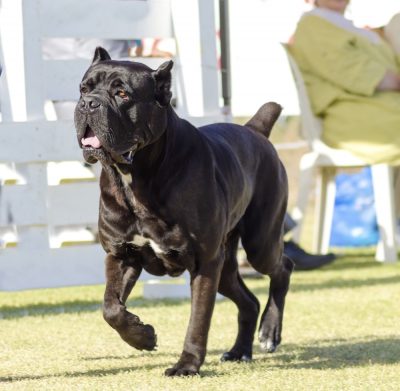One cannot deny the fact that severe dog bite attacks and human fatalities by Cane Corsos happen at disproportionately high rates. For example, Cane Corsos were involved in 21 fatal dog attacks in the United States between 1979 and 1998. However, this statistic in itself does not prove that the breed is inherently dangerous. Rather, it demonstrates that what must be recognized is the presence of genetically-based aggressive tendencies of some individuals. All individuals within the breed should not be stereotyped as dangerous.
Cane Corsos as a breed have been “blacklisted” by insurance carriers and in some municipalities in the United States and in other countries ownership is restricted. Nonetheless, scientific studies have not found support for the effectiveness of Breed Specific Legislation. [1]For example, The Netherlands and Dutch Kennel Club only grants pedigreed certificates to individuals who have past a standardized temperament test.

Popularity
Cane Corso’s ranked 60th in popularity based on AKC registrations in 2012. The breed was officially recognized in the miscellaneous class by the AKC in 2010.
Physical features
The Cane Corso is a muscular, short-haired mastiff type dog. It’s origin dates back to the 15th century in Italy. The name is derived from the Latin “Cohors”, meaning guardian or protector. The breed was developed for protection and hunting. Males weigh between 99-110 lbs. and females between 88-99 lbs. Height is between 23-26 in. at the shoulders. Colors are fawn or bluish gray.
Temperament
The temperament of the breed has been described as being “very loyal, willing to please, highly intelligent, very trainable, unequaled as a watch and protection dog, terribly brave protector of people, house and property, will not back down from other dogs who try to dominate them.”
People partial to the breed stress that Corsos are not fighting dogs and that individuals have the potential to make trustworthy family pets.[2]Moreover, Cane Corso’s probably have a high pain tolerance, similar to pit bull type dogs. From an animal behavior perspective, it’s a no-brainer that adequate socialization and obedience training needs to be instilled at an early age, and owners and family members need to adopt a consistent style of interaction.
- Fatal dog attack by Cane Corso on 4 y.o. boy in Brooklyn, New York
- Second-degree murder charges in Cane Corso fatal dog bite in Michigan
- Near fatal dog bite attack by Cane Corsos in Virginia
- Fatal dog attack by Cane corsos in Italy
- Cane corso causes horrifying knock-down injury to 62 y.o. lady
- Cane Corsos maul teenager in California
- YouTube video about Cane corsos
- Single Cane Corso kills its owner, a 62-year-old man, in California, August 2022
